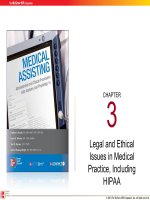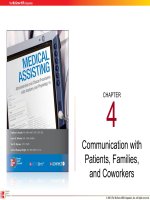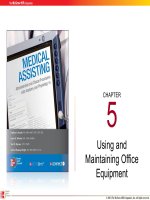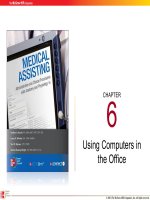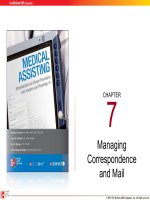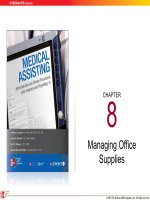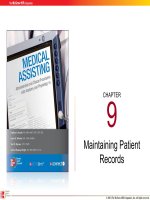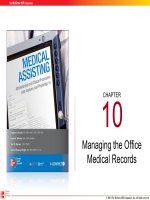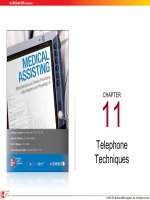Lecture Medical assisting: Administrative and clinical procedures with anatomy and physiology (4/e) – Chapter 39
Bạn đang xem bản rút gọn của tài liệu. Xem và tải ngay bản đầy đủ của tài liệu tại đây (1.09 MB, 67 trang )
CHAPTER
39
Assisting with
Examinations in the
Basic Specialties
© 2011 The McGraw-Hill Companies, Inc. All rights reserved.
392
Learning Outcomes
39.1 Describe the medical specialties of internal medicine,
obstetrics and gynecology, and pediatrics.
39.2 Identify the types of examinations and diagnostic tests
performed in internal medicine, obstetrics and
gynecology, and pediatrics.
39.3 Discuss the role of the medical assistant in working in
internal medicine, obstetrics and gynecology, and
pediatrics.
39.4 Identify common diseases related to internal
medicine, obstetrics and gynecology, and pediatrics.
© 2011 The McGraw-Hill Companies, Inc. All rights reserved.
393
Learning Outcomes (cont.)
39.5 Describe typical treatments for diseases related to
internal medicine, obstetrics and gynecology, and
pediatrics.
39.6 Identify common signs of domestic violence, elder
abuse, and child abuse.
39.7 Carry out the procedure for assisting with
gynecological examinations and procedures.
39.8 Carry out the procedure for meeting the needs of a
pregnant patient during an examination.
© 2011 The McGraw-Hill Companies, Inc. All rights reserved.
394
Introduction
• Specialties
– Specialist – physician with additional training,
residencies, and certification
– Types of examinations and diagnostic tests
– Common diseases and disorders
• Medical assistant
– Assist with specialty examinations
– Observe for signs of domestic violence and child
abuse
© 2011 The McGraw-Hill Companies, Inc. All rights reserved.
The Medical Assistant’s Role in Specialty
Examinations
•
Medical practice
act
–
Defines the exact
duties of physicians
and other healthcare personnel
•
395
Medical assistants
–
May perform
clinical procedures
only under the
supervision of the
physician
State laws vary. You will need to know the scope of
practice for medical assistants in the state where you
work.
© 2011 The McGraw-Hill Companies, Inc. All rights reserved.
The Medical Assistant’s Role in Specialty
Examinations (cont.)
396
• Providing emotional
support
• Providing patient
education
– Effective communication
– Provide educational
materials
– Verify understanding
© 2011 The McGraw-Hill Companies, Inc. All rights reserved.
397
Apply Your Knowledge
What defines the procedures health-care
personnel can perform, and how do you determine
what you are able to do as a medical assistant?
ANSWER: In addition to education, training, and certification,
the state’s medical practice act defines what duties and
procedures health-care personnel can perform. As a medical
assistant, you have to know your scope of practice for the state
where you work.
© 2011 The McGraw-Hill Companies, Inc. All rights reserved.
398
Internal Medicine
• Diagnosis and treatment of
disorders and diseases of the
body’s internal organs
• Internist
– Often first to see patient
– Uses medication and/or
treatment modalities
– Refers to a specialist
© 2011 The McGraw-Hill Companies, Inc. All rights reserved.
399
Assisting with the Physical Examination
• Usually the same as a general
physical examination
• Medical assistant
responsibilities
– Gathering information
• Detect substance abuse, domestic
violence, or elder abuse
– Preparing patient for the
examination
© 2011 The McGraw-Hill Companies, Inc. All rights reserved.
3910
Detecting Substance Abuse
• Signs vary and depend on
– Type of drug
– Patient’s response to the drug
• Report suspicion of substance abuse
to the physician
• Know state requirements for
reporting
© 2011 The McGraw-Hill Companies, Inc. All rights reserved.
3911
Detecting Substance Abuse (cont.)
• Signs of abuse
– Alcohol – depressed pulse rate, respiration,
and blood pressure
– Cocaine – excitation, increased pulse rate
and blood pressure
– Hallucinogens – hallucination, poor
perception of time and distance, severe
panic, violent and bizarre behavior
© 2011 The McGraw-Hill Companies, Inc. All rights reserved.
3912
Detecting Substance Abuse (cont.)
– Inhalants – muscle
weakness, hearing
loss, changes in
heart rate, nausea,
and dizziness
– Marijuana –
reddening of the
eyes, increased heart
rate, heightened
appetite, muscular
weakness
– Narcotics –
drowsiness, depressed
respiration, constricted
pupils, nausea,
vomiting, constipation
– Sedatives – nausea,
slurred speech,
drunken behavior with
no odor of alcohol
© 2011 The McGraw-Hill Companies, Inc. All rights reserved.
3913
Detecting Domestic Violence
• Signs of domestic violence – bring to doctor’s
attention
–
–
–
–
Injuries that the patient tries to hide or excuse
Unusual bruising
Signs in a patient’s tone of voice or choice of words
Self blame
• Reporting suspected domestic violence is
mandatory in some states
• Keep a list of services available for a victim of
abuse
© 2011 The McGraw-Hill Companies, Inc. All rights reserved.
3914
Detecting Elder Abuse
Difficult to detect –
no uniform
definition
Can be mistaken for
falls or chronic
illnesses
Categories
Domestic
Institutional
Self
– Types
• Physical, sexual,
psychological
• Neglect
• Abandonment
• Exploitation
• Occurs in all racial,
socioeconomic, and
religious groups
© 2011 The McGraw-Hill Companies, Inc. All rights reserved.
3915
Detecting Elder Abuse (cont.)
•
Most victims are older women with chronic
illness or disabilities
•
Risk factors
–
–
–
–
History of alcoholism, drug abuse, or violence in the
family
History of mental illness in the abuser or victim
Isolation of the victim from family members and
friends other than the abuser
Recent stressful events affecting the abuser or victim
© 2011 The McGraw-Hill Companies, Inc. All rights reserved.
3916
Detecting Elder Abuse (cont.)
•
Observe interactions
between patient and
caregiver
•
Signs of neglect
–
–
•
Take careful history
–
•
Report suspicions of
abuse to physician
–
–
Foul odor from the
patient’s body
Poor skin color
Inappropriate clothing
for the season
Soiled clothing
Extreme concern
about money
© 2011 The McGraw-Hill Companies, Inc. All rights reserved.
3917
Diagnostic Testing
• Radiologic testing
– X-rays
– CT scans
– MRI scans
– Ultrasound
– Nuclear imaging
• Medical assistant
– Set up
appointments
– Explain procedures
and preps to
patient
© 2011 The McGraw-Hill Companies, Inc. All rights reserved.
3918
Diseases and Disorders
•
Diseases of aging
–
–
–
–
Constipationdiarrhea cycle
Hyperlipidemia
Osteoporosis
Alzheimer’s
disease
•
Infectious diseases
–
–
–
–
Lyme disease
Pneumonia
Rabies
Staph and strep
infections
© 2011 The McGraw-Hill Companies, Inc. All rights reserved.
3919
Diseases and Disorders (cont.)
•
STDs
–
Acquired through
sexual contact with
an infected person
– Patient education
•
•
Prevention
Treatment
– Common types of
STDs
•
•
•
•
•
•
Candidiasis
Chlamydia
Genital herpes
Genital warts
Gonorrhea
Trichomoniasis
© 2011 The McGraw-Hill Companies, Inc. All rights reserved.
3920
Diseases and Disorders (cont.)
Condition
Description
Anemia
Deficiency of iron or vitamins; results from blood loss
Arthritis
Chronic inflammatory disease of tissues of joints
Gout
Metabolic disease caused by the overproduction or
retention of uric acid
Hypertension
Blood pressure greater than 140/90; usually
asymptomatic
Peptic ulcer
Lesion of mucous membrane of the esophagus,
stomach, or duodenum
© 2011 The McGraw-Hill Companies, Inc. All rights reserved.
3921
Apply Your Knowledge
What are the types of elder abuse, and what is the
medical assistant’s role in identification of elder
abuse?
ANSWER: Elder can be abused physically, sexually, or
psychologically. Neglect, abandonment, and exploitation are also
forms of elder abuse. The medical assistant should take a careful
history, observe interactions between caregiver and patient,
observe for signs of abuse, and report suspicions to the
physician.
© 2011 The McGraw-Hill Companies, Inc. All rights reserved.
3922
Obstetrics and Gynecology
•
Specialization of the female reproductive
system
–
Obstetrician – focuses on caring for women
during pregnancy and childbirth
–
Gynecologist – focuses on
conditions of the female
reproductive system
© 2011 The McGraw-Hill Companies, Inc. All rights reserved.
3923
Gynecologic Physical Examination
• Purpose
– Overview of a woman’s health
– Opportunity for cancer-screening exams and tests
• Female assistant should be present during the
exam
– Assist a male doctor
– Provide legal protection
• Your role is similar to that of the general physical
examination
© 2011 The McGraw-Hill Companies, Inc. All rights reserved.
3924
Gynecologic Physical Examination (cont.)
• Physician’s interview
– Evaluation of total
health
– Review of factors that
may indicate cancer or
STDs
• Breast exam
– Check for abnormal
lumps
– Patient education
• Annual mammograms
starting at 40 years old
• Breast exam by
physician annually
• Monthly breast selfexamination
© 2011 The McGraw-Hill Companies, Inc. All rights reserved.
3925
Gynecologic Physical Examination (cont.)
• Pelvic examination
– External genitalia, cervix, vaginal wall, internal
reproductive organs, and rectum
– Speculum – expands the vaginal opening
– Medical assistant’s role
• Assist the patient into position
• Assist the doctor
© 2011 The McGraw-Hill Companies, Inc. All rights reserved.

